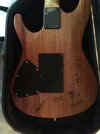JoKeR III
Fractal Fanatic
A few on ebay and reverb.@Andy Eagle These look beautiful! In the USA, I'm trying to find those tuners with the same buttons. So far I can't find them.
A few on ebay and reverb.@Andy Eagle These look beautiful! In the USA, I'm trying to find those tuners with the same buttons. So far I can't find them.
+1. These are great machine heads. I put a set on a new build because I liked the look and bought a second set to swap-out on another guitar because I liked the build-quality. The last Taylor acoustic I bought came with non-locking 510s and those are great, too.View attachment 83215
Just fitted a set of these, no other brand comes anywhere close to this build quality. Better made than most jewellery.
What's the brand/model? Are they staggered?View attachment 83215
Just fitted a set of these, no other brand comes anywhere close to this build quality. Better made than most jewellery.
Awesome …! Quick question, do the tuners weight make the Neck Top heavy?View attachment 83215
Just fitted a set of these, no other brand comes anywhere close to this build quality. Better made than most jewellery.
I couldn't find anything with 510 in the name. I think these are SG381 MG-T...Staggered 3 and three (works fine) Gotoh 510 magnum lock traditional . And the are no heavier than any other locking tuner so no neck dive unless you have a really poorly balanced guitar to start with.
https://www.ebay.co.uk/itm/291771466134?epid=2280252584&hash=item43eeef4196:g:tU0AAOSwlXddodcTI couldn't find anything with 510 in the name. I think these are SG381 MG-T...
Here's a link at StewMac:
https://www.stewmac.com/parts-and-h.../gotoh-magnum-lock-trad-6-in-line-tuners.html
Thanks... I tend to avoid eBay these days.
The pandemic has affected supply of a lot of parts. They are in the 2021 Gotoh catalog.Are they not made any more?
I have 2 guitars that I stripped of paint and finished with hand-rubbed poly.I would like a simple clear finish on this body.
I am thinking of applying a finish such as Minwax Polyurethane, oil based, by hand, not spraying it.
Any thoughts?


